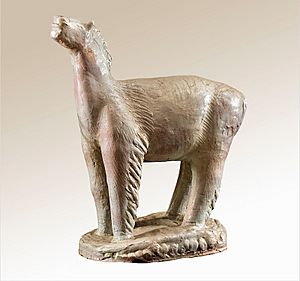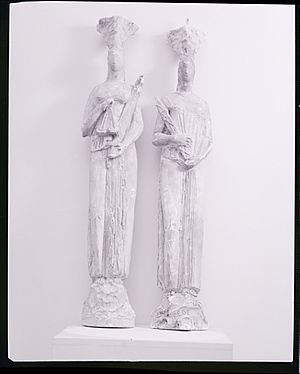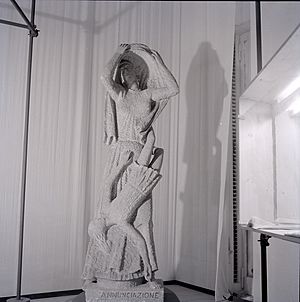Arturo Martini facts for kids
Arturo Martini (1889–1947) was a very important Italian sculptor. He worked between World War I and World War II. His art mixed old Roman styles with modern ideas. He made many public sculptures in Italy during a certain time, but later he decided to stop making art altogether.
Early Art and Futurism
Arturo Martini was involved with the Futurist art movement from 1914 to 1918. He wrote letters to Umberto Boccioni, a famous Futurist artist. In 1918, Martini even made a small book about modern art. His early sculptures often looked old-fashioned. They sometimes had flat shapes and many different colors.
Sculptures in Italy
Later, Martini's art went back to a more classic style. But he added his own clever and flexible touch. He was able to mix and use ideas from many different art styles. Between the two World Wars, he became a main sculptor for the government in Italy. He had many projects to complete. He created large monuments and sculptures for courthouses, churches, and universities.
For example, he made a big bronze sculpture for La Sapienza University in Rome. He also created a memorial for the pilot Tito Minniti. Another important work is the monument to the Fallen at the Palazzo delle Poste, Naples.
After the War
After the government changed, Arturo Martini felt that his art had been used for the wrong reasons. In 1945, he wrote an essay in a magazine called La Martini. In it, he said that sculpture was a "dead language." He wrote: "scultura, lingua morta." This meant he thought sculpture was no longer important.
Even though he criticized his own art form, he made one important sculpture after the war. It was a marble sculpture to honor a war hero named Primo Visentin. Visentin was also known as "Masaccio." He had died at the end of the war in Loria, Italy, for reasons that are not clear.
Martini used many different materials for his sculptures. These included clay, wood, plaster, stone (especially marble), bronze, and silver. He usually made sculptures that looked like real people or things. However, he could also create abstract forms, which are shapes that don't look like anything real. An example of this is his 1944 work called Vibrations of a Head. Arturo Martini inspired many other Italian sculptors. Some of them include Marino Marini, Emilio Greco, Marcello Mascherini, Pericle Fazzini, and his student Fiore de Henriquez.
Gallery
See also
 In Spanish: Arturo Martini para niños
In Spanish: Arturo Martini para niños





